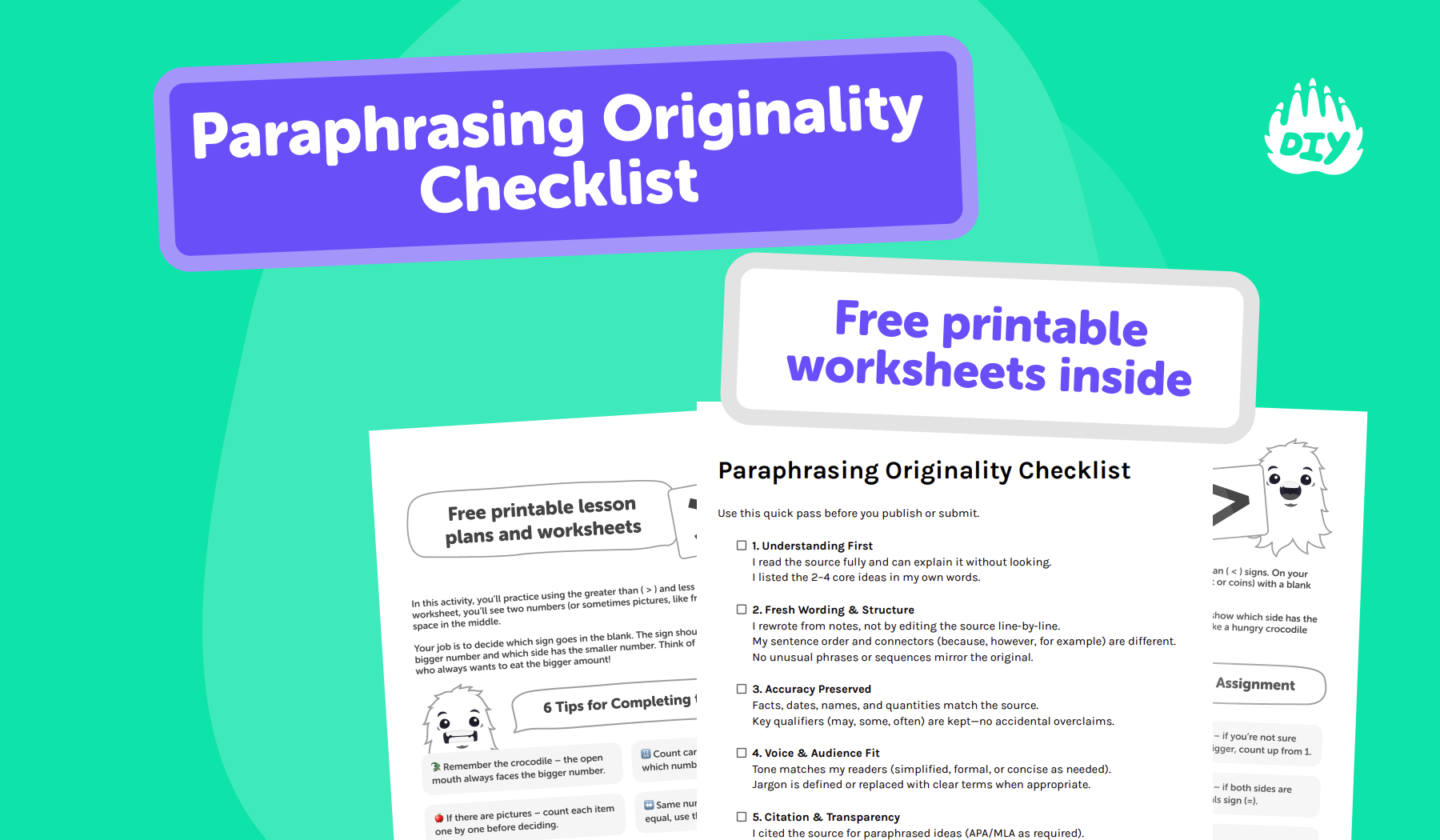Paraphrasing is restating someone else’s idea in your own words and structure while giving credit to the source. It’s not a quick synonym swap; it’s a fresh telling that keeps the original meaning intact. Done right, paraphrasing helps you understand deeply, avoid plagiarism, and keep your voice.
Promise: You’ll get a simple method you can reuse, real examples of weak vs. strong paraphrases, a quick reference table, and an originality checklist you can print or share with students.
Need step-by-step support that keeps kids in charge? - DIY’s AI Homework Helper coaches thinking, not shortcuts with prompts, practice, and guardrails that build real skills.
Paraphrase vs. summary vs. quote
Paraphrase: Same idea, new sentence structure and wording, with a citation.
Summary: A shorter version that captures the main points, with a citation.
Quote: Exact wording from the source in quotation marks, with a citation.
One-line test: If your version still tracks the source sentence-by-sentence with small word swaps, it’s not a paraphrase rewrite from the idea up.
A simple, repeatable paraphrasing technique
Step 1. Understand first. Read the passage and set the source aside.
Step 2. Note the core ideas. Write 2–4 key points in your own words.
Step 3. Rewrite from notes. Compose fresh sentences in a new order.
Step 4. Compare and refine. Remove look-alike phrasing and echoes.
Step 5. Cite the source. Paraphrases still need attribution.
You distance yourself from the phrasing, focus on meaning, then rebuild with your natural voice.
Side-by-side examples (weak vs. strong)
Source (neutral topic): “Regular sleep supports memory, mood, and attention. Students who maintain a consistent schedule often perform better on complex tasks.”
Weak paraphrase (too close): “Regular sleep helps memory, mood, and attention. Students who keep a consistent schedule usually do better on complex tasks.” Why it fails: Same order and structure; just swapped a few words.
Strong paraphrase: “Keeping a steady bedtime routine can boost how well you remember, focus, and feel during the day. For many students, this consistency shows up as better performance on challenging work.”
New sentence shapes, different connectors (“can boost,” “shows up as”), same meaning.
Source (with a number): “The survey found that 68% of respondents preferred study sessions under an hour.”
Weak paraphrase: “According to the survey, 68% of people liked study sessions under an hour.” Why it fails: Same structure and wording pattern.
Strong paraphrase: “In the survey results, about two-thirds of participants favored study blocks shorter than 60 minutes.”
Numeral reframed (still accurate), structure changed, wording fresh.
Prefer coaching over copy-paste? Use a tool that explains, quizzes, and checks understanding then you do the writing. 👉 Open AI Homework Helper
Tone, voice, and audience fit
Paraphrasing keeps meaning, not the author’s style. Match your readers: simplify for a student guide, or keep terms precise for research. Use domain vocabulary you’d naturally use. If a definition or distinctive phrase is essential, quote it briefly and cite.
Using tools responsibly (and staying original)
Tools can help you brainstorm, organize, or spot awkward wording but you do the writing. Treat outputs like rough clay: reshape structure, verify facts, and adjust tone. Keep a citation anytime the idea came from a source, even if the sentences are yours.
Quick tool hygiene:
Don’t accept a first draft. Rewrite from notes.
Preserve facts and qualifiers (e.g., may, often, some).
Keep your voice trim filler and generic phrasing.
How to cite a paraphrase (APA & MLA, one-minute refresher)
APA (author–date): Narrative: Smith (2024) explains that … Parenthetical: (Smith, 2024) Include page/paragraph if required or helpful.
MLA (author–page): Narrative: Smith explains that … (24). Parenthetical: (Smith 24). If no page, use what’s available (chapter/section if your style guide permits).
Remember: You cite ideas, not just quotations. If your paragraph relies on a source’s thinking, give credit.
Common mistakes to avoid
Word swaps without structure change. If the skeleton matches, it’s not original.
Losing precision. Keep numbers, names, and cautious language.
Over-paraphrasing one source. Blend multiple sources and your analysis.
Forgetting to cite. Paraphrases need attribution.
Over-smoothing technical terms. Define them or keep them precise, don't blur meaning.
Ready to make homework calmer? Get gentle hints, examples, and self-checks across reading, writing, and math kid-safe by design.👉 Start with AI Homework Helper
Quick comparison table
Thing | Paraphrase | Summary | Quote |
Length | Similar | Shorter | Exact length |
Wording | New | New | Original text |
Structure | New | New | Original text |
Citation | Required | Required | Required |
When to use | Preserve detail but change language | High-level overview | Distinctive wording or precision |
Originality workflow (fast quality control)
Read-back test: Out loud, does it sound like you?
Source-distance test: With the source closed, can you still explain the idea clearly?
Structure check: Are sentence openings and order different?
Accuracy pass: Numbers, names, and qualifiers intact.
Citation: Attribution present where the idea came from a source.
Optional: Run a plagiarism checker, but interpret results thoughtfully (false positives happen with common phrases).
Downloadable: Paraphrasing Originality Checklist

Offer this to readers (or students) as a one-page, print-ready reminder. Download the checklist
FAQ about plagiarism and paraphrasing
Is paraphrasing plagiarism?
Not if the idea is credited and the writing is your own. Change both wording and structure, and cite the source.
Do I need to cite if I paraphrase?
Yes. You’re using someone else’s idea, even if the sentences are new.
What’s the difference between summarizing and paraphrasing?
A summary is shorter and broad; a paraphrase keeps detail but changes the language and structure.
Can I paraphrase statistics?
Yes, but don’t distort them. Reframe (e.g., “about two-thirds”) if it stays accurate.
Are paraphrasing tools cheating?
They’re fine for brainstorming or grammar support, but you must rewrite, verify, and cite where ideas aren’t yours.
Wrap-up
Original writing starts with clear understanding. Read first, list the core ideas, rebuild in a new structure, then cite. Use tools to coach not to replace your thinking. And when in doubt, run your Originality Checklist before you publish.
Download the checklist. Try the kid-safe AI Homework Helper to coach the process step by step.




